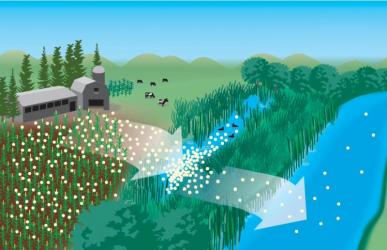Farmers embrace big data to reduce pollution
So called “big data” – the collection and use of gigantic data sets – is much in the news these days. Often, the subject comes up in relation to personal privacy, as with the collection of personal emails and other data by the National Security Agency (NSA), or by businesses capturing records of our online activities to improve their ability to get us to buy whatever it is they are selling.
But big data is also a huge deal for the food system and for farmers. As a recent article in the Southeast Farm Press explained, the collection, analysis, and use of data is changing how farmers grow our food. This is creating huge opportunities to improve efficiency, generate sustainability benefits, and relieving farmers “of much of the day-to-day guesswork associated with farming.”
Today, farmers can get real time information about everything from the nutrient status of their crops to emergence of weeds to moisture levels in their soils. Other examples include:
- Field samples from corn stalks or leaf tests can provide a snap shot or a report card on how much nitrogen a corn crop is taking up or needs.
- High resolution spatial maps can lay out soil moisture levels to guide efficient use of irrigation.
- Farmers can get detailed maps of pest damage to target more precisely pest control applications.
- Aerial imagery or satellite imagery can show a farmer how a crop is growing and help identify problem areas and facilitate specific management decisions.
- There are even new models that help farmers adjust their nutrient applications based on recent weather.
By gathering and using more data about the nutrient needs of their own fields, for example, farmers can become much more efficient in applying fertilizer, reducing what is lost to water or air and saving themselves money. This benefits all of us, because nutrients that are not taken up by crops can lead to water pollution and greenhouse gas emissions. In addition, once they have detailed information about how water moves across and through the agricultural landscape, farmers and watershed managers can be much smarter about where to put filters like buffers and wetlands that capture nutrients that run off fields. This, in turn, improves water quality in the streams, rivers and lakes that the nutrients would otherwise wash into.

When too much fertilizer is applied to crops, the excess runs off and pollutes waterways.
Ultimately, data-smart farmers will be able to keep more land under production, since they won’t have to guess where to maintain buffers and wetlands. This kind of precision filtering will also save society money, because buffers and wetlands are a much less costly way of assuring clean water than water treatment plants.











